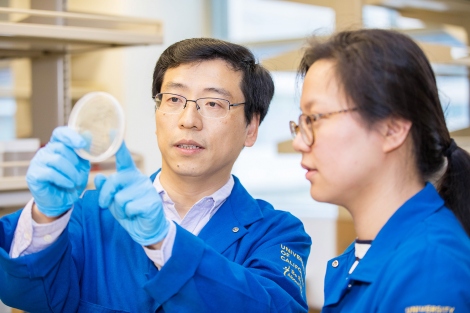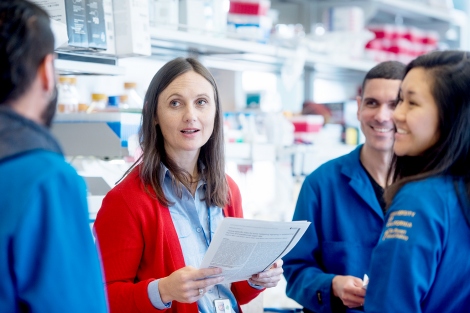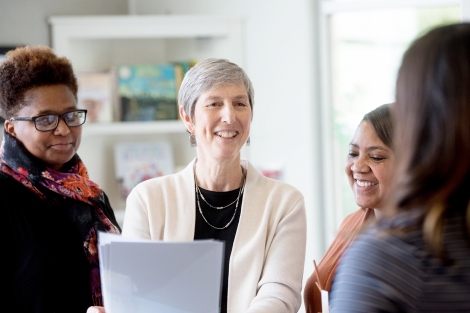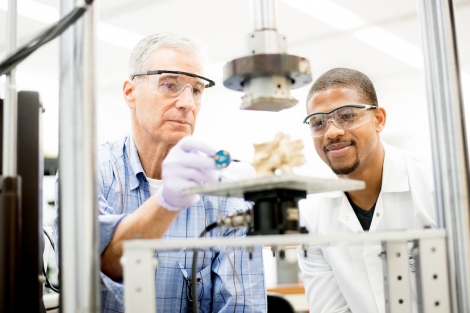2017 NIH Funding: A Look at the Top-Funded Researchers and Their Work
UC San Francisco received more than $593.9 million in federal funding from the National Institutes of Health in 2017 for research across multiple health-science arenas at the University.
From understanding the key biological functions to translating findings into treatments and cures for patients, the highly competitive awards and grants are crucial to the research across our schools of dentistry, medicine, nursing, pharmacy and the Graduate Division.
Below are a few highlights of researchers who received the most NIH funding and how their NIH grants are helping them to change the future of health.
School of Medicine

1. Nevan Krogan, $7,665,115
2. Prescott Woodruff, $7,434,859
3. Steven Deeks, $6,985,595
4. Michael McManus, $6,951,390
5. Stanton Glantz, $5,043,512
Chronic obstructive pulmonary disease, or COPD, is the third-leading cause of death in the world. Current treatments for COPD can improve symptoms and reduce exacerbations but neither cure the disease nor slow its progression.
Treatment recommendations depend on clinical factors such as severity of symptoms and frequency of exacerbations. However COPD is biologically heterogeneous, and a poor understanding of the biological subtypes of COPD limits the effectiveness of these treatment recommendations.
Prescott Woodruff, MD, attempted to identify the underlying biomarkers of the different biological subtypes of COPD through SPIROMICS, a longitudinal cohort of nearly 3,000 smokers with and without COPD. Better knowledge of and discrimination between subtypes can inform treatment decisions and provide faster, more targeted relief to patients.
For example, some patients have asthma-like inflammation even though they’ve never been diagnosed with asthma. These individuals can be helped by steroid inhalers, but patients without this type of inflammation should not use steroids because they can have negative side effects. Woodruff says biomarkers can help identify the patients who should be treated.
“Our goal is to connect the underlying biology to clinical manifestations and to get the right drugs to the right people,” said Woodruff, professor of medicine. “Part of our work is designed to help us understand what new therapies we can develop, and part of it is to help us understand how to target existing therapies.”
SPIROMICS 2, a five-year extension of the original project, has three main objectives: track the progression of people who show symptoms of COPD but do not meet the criteria for diagnosis; determine whether the biological root of emphysema is a problem with the lung’s airways or blood vessels; and understand the biology of COPD exacerbation, a sudden worsening of bronchitis symptoms.
However, the impact of the study extends well beyond the scope these three aims. “We’re doing a lot of things ancillary to those main goals, with 65 ongoing subsidiary studies,” said Woodruff. “SPIROMICS is really a scaffold on which a lot of other research can be done.”
School of Pharmacy

1. Ruth Greenblatt, $4,122,513
2. Kathleen Giacomini, $2,506,218
3. Shuvo Roy, $2,342,670
4. Lei Wang, $2,037,521
5. Nadav Ahituv, $1,516,199
One of the most remarkable technological advances in neuroscience over the past decade has been optogenetics – the ability to control the activity of brain cells by shining different wavelengths of light on them. Lei Wang, PhD, is working to take this technology one step further by controlling the proteins within a cell.
“We are trying to build a novel technology that enables us to control a selected protein simply using light, moving the resolution of optogenetics from the cellular level to the molecular level,” said Wang, associate professor of Pharmaceutical Chemistry.
In optogenetics, cells are engineered to produce specific proteins made up of a hundred amino acids – the building blocks of a protein – that are sensitive to light. When a light is shined on the cell, the protein can activate or inhibit it. The new technology uses just a single amino acid that can be inserted into any protein and make it responsive to light.
Wang is particularly interested in manipulating the proteins that form chemical receptors on the surface of cells. Receptors can have many subtypes, each with a different response to the corresponding chemical and thus a different effect on the cell. By specifically targeting the receptor subtypes and monitoring their downstream effects, Wang hopes to pinpoint each one’s function. For example, turning one particular subtype of receptor on or off using light could influence whether the cell fires or not and provide valuable information about the protein’s role.
While his initial goal is to develop the technology, in the long run, Wang hopes to use the technique to answer questions about the molecular mechanisms of memory, such as which receptor subtypes contribute to long-term memory formation.
“We can use this technology to study the function of different proteins in live cells or tissues so that we can understand their contribution to neural processes or diseases,” said Wang.
School of Dentistry

1. Stuart Gansky, $3,397,109
2. Sarah Knox, $1,808,618
3. Jon Levine, $1,710,657
4. Ophir Klein, $1,469,875
5. Shingo Kajimura, $1,091,363
Radiation therapy is a lifesaver for patients with head and neck cancer, but the treatment takes a toll on the salivary gland. Salivary gland dysfunction causes serious oral health problems, including dry mouth, gum recession, impaired wound healing, and tooth loss, as well as an altered sense of taste. In short, anything you do with your mouth will be affected.
Sarah Knox, PhD, an assistant professor of cell and tissue biology in the School of Dentistry, is working to improve patients’ quality of life by repairing damaged salivary gland tissue with stem cells.
In earlier research, Knox discovered that the salivary gland has its own pool of stem cells to replenish gland cells that die off. However, after radiation the stem cells do not regenerate the damaged tissue like they should. Knox thinks this is because the stem cells require signals from nearby nerve cells to start the maturation process, but the nerve cells also stop functioning when the gland tissue dies.
Knox developed a chemical compound that can be injected into the gland to mimic the signals from the nerve cells and reactivate the repair process with the stem cells. However, there’s a possible wrench in the plan: the therapy needs to work in older adults who most often require this treatment, but the whole process of tissue regeneration slows down and becomes more difficult with age.
“We know we can reactivate stem cells in young mice, but do older stem cells still have regenerative capacity?” she asks. “We think the therapy has great potential, but we need to make sure it can help the population who needs it most.”
Knox is now testing whether the strategy is as effective at reactivating stem cells and regenerating damaged tissue in old mice as it is in young mice.
School of Nursing

1. Christine Miaskowski, $2,020,029
2. Sandra Weiss, $1,567,997
3. Xiao Hu, $717,609
4. Barbara Koenig, $664,427
5. Abbey Alkon, $655,745
Children chronically exposed to pesticides early in life have an increased risk for cancer, neurodevelopmental problems, asthma and obesity. Abbey Alkon, RN, PNP, PhD, is trying to protect pre-school-aged children (three to five years old) by reducing pesticide levels at child care centers through nurse-led intervention programs.
“Young children are crawling on the floor, picking up things and putting them in their mouths. They’re more likely to get exposed to pesticides that are sprayed and settle on the ground than an adult,” said Alkon, a professor in the Department of Family Health Care Nursing. Kids are particularly vulnerable to the toxic chemicals because their organs are also still developing.
The initiative offers classroom assessments and monthly consultations to educate teachers and provide them with alternative methods to deal with pests. For example, the program – called Integrative Pest Management (IPM) – recommends using contained bait boxes instead of sprays to kill ants or cockroaches. The intervention also focuses on preventing pests in the first place by eliminating their access to food, water and shelter. In addition, the study will assess exposure to pesticides in the environment, as many of the child care centers are in high agricultural areas.
Before and after the seven-month program, researchers will sample pesticide levels in dust in the child care centers, as well as through silicone wristbands some of the children will wear. They will also compare levels in centers that did not receive the Integrated Pest Management training to see if the program made a difference.
“In California, 62 percent of children under 6 years of age are in some type of child care,” said Alkon, who trained as a pediatric nurse practitioner and epidemiologist. “By focusing on these settings instead of the home, we can reach more children and have a greater impact. Kids come and go, but that center will be a healthy environment for generations of children to come.”
Centers and Institutes

1. Clinical and Translational Sciences Institute (PI: Jennifer Grandis), $18,421,932
2. Helen Diller Family Comprehensive Cancer Center (PI: Alan Ashworth), $6,950,396
3. Center for Dental, Oral, and Craniofacial Tissue and Organ Regeneration (PI: Jeffrey Lotz), $5,113,342
4. Autoimmunity Center of Excellence (PI: David Wofsy), $4,617,038
5. UCSF-GVI Center for AIDS Research (PI: Paul Volberding), $3,072,002
Translating a new therapy from bench to bedside can sometimes be more challenging than developing the technology itself. A new center headed by Jeffrey Lotz, PhD, aims to make this process smoother and more efficient for scientists, and provide greater potential benefit for patients.
With a focus on regenerative therapies for craniofacial problems, the Center for Dental, Oral and Craniofacial Tissue and Organ Regeneration (C-DOCTOR) acts as an incubator for promising new technologies. The goal of the center is to guide a portfolio of projects from basic research to clinical trial over the course of five to eight years.
“Only 10 percent of biotech startups ever get to the clinical trial stage. We hope to increase the odds for these projects by providing them with the infrastructure to progress in an accelerated fashion,” said Lotz, a professor of orthopedic surgery at the School of Medicine.
The center is a collaboration between eight California universities, with UCSF as the lead. The universities provide teams with funding and the tools needed for clinical translation, particularly things basic scientists might not be familiar with. For example, scaling up manufacturing, regulatory issues, and partnerships with biotech companies.
The first eight projects target clinical areas such as bone defects, salivary glands, and skin wounds using a variety of regenerative methods, such as stem cells, biomaterial scaffolding, and harnessing regenerative signal secretion. Lotz says the teams are currently refining the “secret sauce” of their technology, how the therapy exerts its disease-modifying capability, and how to maintain that component in a way that can be scaled-up to safely disseminate to patients.
“The technologies we’re interested in have gone through the basic proof of principle work and are at the right maturity stage,” said Lotz. “We also have to ensure there’s a market for the therapy and that they are high impact enough to generate interest from industry partners to support the eventual clinical trials.”